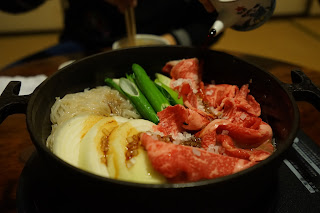"Sukiyaki" is traditional cuisine
consists of thinly sliced beef and vegetables simmered on sauce pan. It was the
great among all dishes that I've enjoyed with my Argentine friend. Her country
is famous for its large amount of production and consumption of beef. Also
Argentine has traditional beef dish called "Asado" that literally
means "grilled" or "barbecued" in Spanish. Maybe she would
enjoy the different cooking style of beef. That's one of the reason why I had
chosen Sukiyaki for the dinner.
One thing I was concerned about Sukiyaki is
that it is served with bowl of raw beaten eggs. After it was well cooked, we
picked some pieces of beef and dipped them into the bowl.
How
was the verdict?
¡Qué rico!
I'm happy because she really liked it. Actually the mixture of Sukiyaki sauce with beef and raw beaten eggs is melt in your mouth. That also made my face melt like above picture. I have to admit I was so relaxed with enjoying Sukiyaki in traditional Japanese room. Japanese Sake also goes well with Sukiyaki.
I'm happy because she really liked it. Actually the mixture of Sukiyaki sauce with beef and raw beaten eggs is melt in your mouth. That also made my face melt like above picture. I have to admit I was so relaxed with enjoying Sukiyaki in traditional Japanese room. Japanese Sake also goes well with Sukiyaki.
This
Sukiyaki restaurant uses only soy sauce and sugar as seasoning. As the sugar
melt and mixed with soy sauce and oil from beef, it produced the distinct
aroma. It gave me the sense of nostalgia that took me back to good old days of
Japan.
Sukiyaki
was invented in the time when Japan opened its port to the West. That dates back
to late 19C. Originally we didn't have the custom to eat meat because of the
Buddhist teaching. As western people brought their meat to Japan, people were
influenced by their food culture and then Japanese invented own way to enjoy
beef dish. That was the origin of Sukiyaki as we know it today.
Not only food
but also veichle was also invented in that period. That was Rickshaw, veichle
pulled by a man. It is called "jinrikisha" in Japanese,
"jin" means human, "riki" means force, and "sha"
means vehicle. So it literally means "human-powered vehicle" and the
English word "Rickshaw" is derived from Japanese word
"rikisha". We tried it when we visited Arashiyama after enjoying
Studio Park in Uzumasa.
It was perfect
transportation for us to enjoy the views of Arashiyama efficiently. Olden days,
Arashiyama was one of the resort for aristocrat to escape from daily life and
they trip to there by using Ox-Cart. For Samurai lord or ordinary people in
feudal Japan, there was the other human forced transportation “Kago”, kind of
palanquin but it took place for rickshaw in late 19C.
Rickshaw was
faster than Ox-Cart and “Kago” palanquin and it spread rapidly just after Japan
open its door to the West. Maybe Japanese needed faster transportation to catch
up with Western civilization. For that purpose, we also needs nutritious food
such as meat so “Sukiyaki” was encouraged by cultured people, for example,
Yukichi Fukuzawa, the man you can find on ten thousand yen bill recommended Japanese meat
consumption to be stronger. Maybe “Sukiyaki” contributed for Japan to make its
military and economy stronger.
Although we spent a "Yukichi" ten thousand yen for the amount of Rickshaw and Sukiyaki, it was worth paying. We could save and gain out energy by taking rickshaw and eating Sukiyaki for the next day activity!
Although we spent a "Yukichi" ten thousand yen for the amount of Rickshaw and Sukiyaki, it was worth paying. We could save and gain out energy by taking rickshaw and eating Sukiyaki for the next day activity!

No comments:
Post a Comment